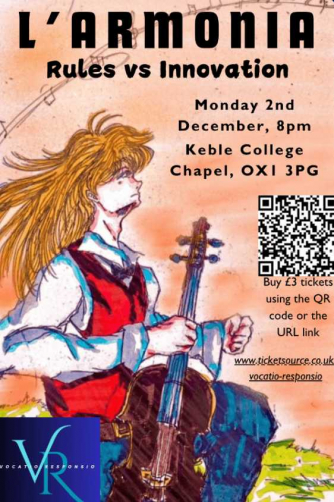Details
Keble College Chapel
16 Parks Rd
Oxford
Oxfordshire
OX1 3QD
England
Programme
Unico Wilhelm Wassenaer – Concerto Armonico no.3 in A Major
Heinrich Ignaz Franz von Biber – Harmonia Artificioso-Ariosa: Trio Sonata no.6 in D Major
Georg Muffat – Armonico Tributo: String Sonata no.1 in D Major
~ Interval ~
Antonio Vivaldi – Concerto for 4 Violins in E minor, RV 550 (Op.3 no.4)
Antonio Vivaldi – Violin Concerto in E flat major 'La Tempesta di Mare', RV 253
Performers
Samuel Oliver-Sherry – violin / director
Vocatio:Responsio
Other concerts in this Series (+)
Programme Note
A word with equal importance in both musical and religious disciplines, it’s no wonder that composers in the eighteenth-century valued harmony in their music. Dating back to the Pythagorean school and ‘musica universalis’, the view of harmony as a reflection of divine order, encompassing unity and peace, made its way into musical expression. And, as composers start to give more descriptive titles to their collections of musical pieces (a tradition perhaps pioneered by Heinrich Ignaz Franz Biber), harmony is very much a common theme: Unico Wilhelm Wassenaer composed six harmonic concertos, while Georg Muffat provided five tributes to harmony, for example.
However, the opposition to this traditional compositional technique is the art of genuine human emotion and innovation, something that disregards technique in favour of a more spontaneous production of art. As with any opposing pair, they may be thought of as concepts that complement and directly empower each other (Pythagoras’ thought that mathematics could explain the human sentimental world, for example), or as items that exist in conflict. Antonio Vivaldi gives both sides: while his Op.3 set of concerti published in 1711 balances such spontaneity (estro) with formal control (armonia), his Op.8 publication in 1725 changes the tune, squaring them of as direct opponents, struggling to cease full control of the compositional brain. And so, in the second of Vocatio:Responsio’s concerts this 2024-25 season, we explore this struggle between harmonic, technical rigour and genuine humane innovation in eighteenth-century music, with the particularly overt case study of Vivaldi’s Op.3 and Op.8 a representation of this.

 Your events at Classical Events
Your events at Classical Events

